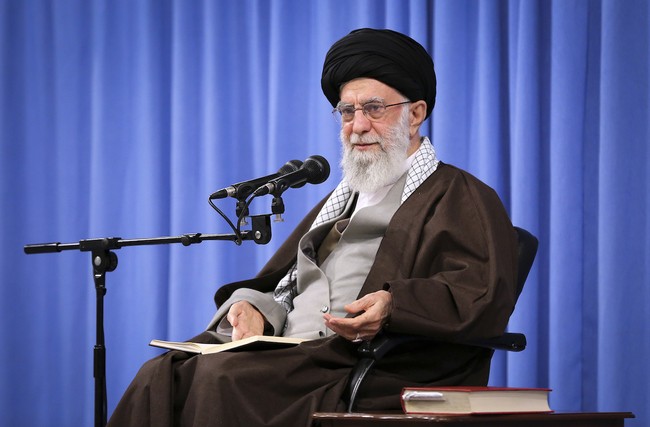


The Iranian regime is facing a nervous breakdown as infighting escalates over attempts to negotiate with the Trump administration in America. Hardline factions regard the Americans as ‘The Great Satan’ and eschew all efforts to reopen nuclear talks with President Trump. Meanwhile, pragmatists amongst the leading mullahs fear the theocratic regime has been fatally weakened by the defeats of Hamas in Gaza and Hezbollah in Lebanon and by the collapse of the Bashar al-Assad tyranny in Syria. They face the nightmare scenario of a collapsing economy, together with a growing social and political crisis at home, while Trump threatens to double down on his ‘maximum pressure’ sanctions campaign, to sever the last of their oil income. They are desperately seeking new negotiations to revive the moribund Joint Comprehensive Plan of Action (JCPOA) nuclear deal, which Trump unilaterally withdrew America from during his first term in the White house, describing it as “the worst deal in American history.”
On January 31, the U.S. office of the National Council of Resistance of Iran (NCRI), the main democratic opposition movement, held a press conference in Washington, D.C. revealing the Iranian regime’s covert activities in its nuclear bomb-making program. The NCRI revealed how the mullahs are offering renewed nuclear negotiations as a decoy to hide their clandestine plans to build a nuclear weapon. The regime is effectively trying to buy time, by offering talks with the U.S. and the EU, and in particular, with the UK, France and Germany, habitual appeasers of the mullahs. At the press conference, the NCRI released a classified internal memo leaked from Tehran, which exposed the covert plan by the regime to develop nuclear warheads for solid-fuel missiles with a range of over 3,000 km (1,864 miles) at their Shahrud and Semnan missile sites, around 410 km (254 miles) east of Tehran. Shahrud is the site of the Islamic Republic’s Iranian Space Agency. Both sites are heavily militarized, and public access is severely restricted.
Reeling from the NCRI’s most recent exposure of their secret nuclear program, the Iranian regime quickly organized their own high profile press conference, to unveil a new underground missile city equipped with electronic warfare facilities. On February 1, the Islamic Revolutionary Guard Corps (IRGC) disclosed what they described as an “underground missile city” on the Southern Iranian coast. State-run media in Iran said the naval arm of the IRGC had showcased a subterranean base housing cruise missiles designed to target destroyers in strategic southern waters, including the Persian Gulf and the Gulf of Oman. The media reports claimed that IRGC Chief Commander Major General Hossein Salami had visited the “missile city” to inspect the navy’s missile units at the beginning of the month. He claimed the site only represented “a small part” of the regime’s underground and field missile cities that housed dozens of assault boats armed with missile launchers that were equipped to be operational in the shortest possible time. The media reports followed an earlier interview with Admiral Habibollah Sayyari, Chief of Staff and Deputy Coordinator of the Iranian Army, who said his country “is fully prepared to confront any threats, no matter where they originate.”
Recommended
State television in Iran also broadcast a film of the Iranian president Masoud Pezeshkian, visiting what was described as a new ballistic missile, named Etemad or “trust” in Farsi, which they claimed had a range of 1,700 km (1,056 miles), capable of reaching its arch-enemy Israel. As the war in Gaza and Lebanon spilled over last year, the Iranian regime twice launched a barrage of missiles directly at Israel, prompting an unprecedented and devastating response which neutralized Iranian defense systems and exposed the regime’s vulnerability to attack. In a derisory effort to project an impression of military strength, President Pezeshkian stated that: “The development of defense capabilities and space technologies... aims to ensure that no country dares to attack Iranian territory.”
Western analysts believe the underground missile city revelations amount to saber rattling by the mullahs’ regime, who hope to frighten the West into reducing economic sanctions in exchange for nuclear decommissioning. Tehran has boasted how it has accelerated uranium enrichment to almost weapons-grade purity since America withdrew from the JCPOA. However, it is well known that such tactics have been tried before and have always failed. The Iranian regime repeatedly used the cover of the JCPOA nuclear negotiations to disguise its rush to build a nuclear warhead. The terms of the original JCPOA deal, orchestrated by President Obama, even prohibited UN International Atomic Energy Authority (IAEA) inspectors from visiting IRGC or other military sites, where it was known that most of the secret nuclear program was being facilitated.
It was the NCRI who first revealed the existence of the Iranian regime’s nuclear agenda back in 2002, exposing its two nuclear sites at Natanz and Arak. Prior to this, Western intelligence agencies had been completely unaware of the mullahs’ clandestine nuclear activities. Ali Akbar Salehi, the former head of the Atomic Energy Organization of Iran (AEOI), detailed how the regime, with Supreme Leader Ayatollah Ali Khamenei’s full knowledge, purposefully misled the IAEA regarding the Arak heavy water facility. Western experts believe that the regime is now so weakened that it requires a nuclear bomb more than ever to regain a sense of hegemony in the Middle East. It has intensified domestic oppression and implemented a frenzy of executions to deter a further nationwide uprising, which the mullahs fear could sweep them from power. Over 1,000 executions, mostly of political prisoners, took place last year.
The West must not fall for false promises of nuclear decommissioning. All of the regime’s nuclear sites must be shut down, with unrestricted IAEA access to all of Iran’s nuclear facilities. The regime’s pattern of deception remains an ongoing threat. Lifting sanctions will only embolden them to accelerate nuclear enrichment. The West must wake up to the reality that only providing moral support for the Iranian people and their organized resistance, will ever enable this evil regime to be overthrown.

